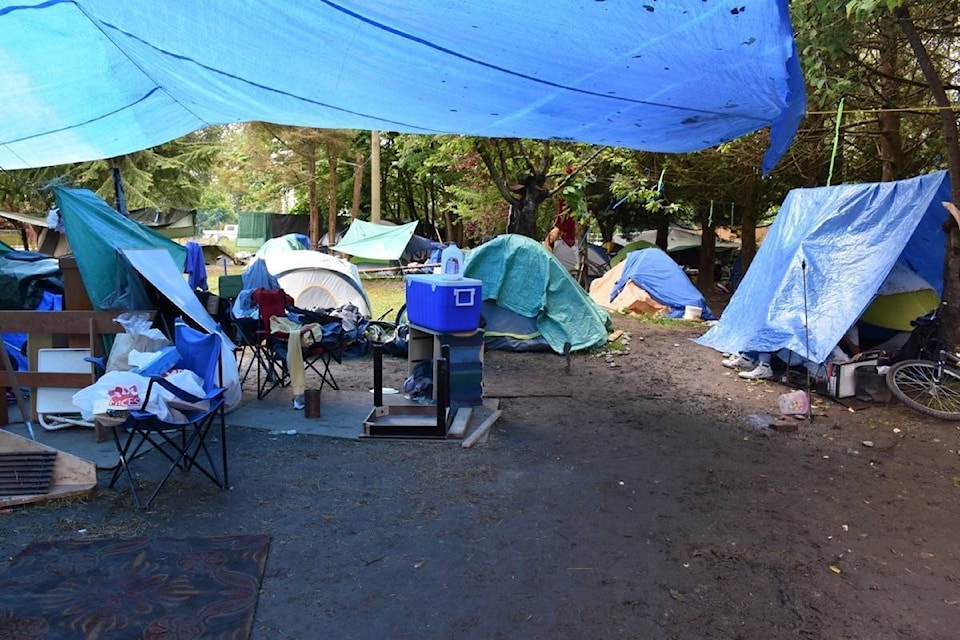Only days before summer officially begins, the first heat warning continues to be in effect for Metro Vancouver, including Maple Ridge.
Environment Canada expected temperatures will reach the low 30s today – about 10 C above the average temperature for mid-June.
Michael Schwandt, medical health officer at Fraser Health, said the most high-risk population includes people at extremes of age and those who have prolonged exposure to the outdoors.
“Someone who is staying outside, who is homeless or underhoused would certainly be at an increased risk for heat illness or heat stroke,” said Schwandt.
At Anita Place Tent City, a homeless camp in Maple Ridge, a resident named Lexie said heat brings on a variety of issues.
“There’s bugs, you get eaten alive by mosquitoes. The tents keep them out, but that’s only if you don’t have holes in your tents. Once our tent tears, we arn’t set up to go out and buy an expensive tent,” she added.
Lexie said finding a cool place within the tent city is uncommon.
“Even if you keep your tent sealed all day, it all depends on the colour of your tent and where it is. It either becomes a sauna or a place of relief. Every tent I’ve entered yet has been a sauna.”
Lexie said working odd jobs is also difficult when the temperature is high.
“Everything’s slowed down. We can collect bottles or offer to help build or clean things to make money. You don’t see that right now, you’re more likely to see people try to come up with ways they physically can go make money. Which isn’t easy.”
To access water, Lexie said residents share one hose or use the bathroom sink, but she worries about transmittable diseases in the bathroom and cleanliness of the hose water. Lexie said some residents don’t share the hose, so it could take hours to access it.
At the Salvation Army Ridge Meadows Ministries, executive director Darrell Pilgrim said people can access shade and iced water there.
“Outside in our facility we have the courtyard with picnic tables and shade, so people can rest there if they need to. We also provide cambros [containers] filled with ice water and replenish that throughout the day for anyone that needs water. If anyone comes and has a large jug they want to take with them to their camp or wherever, we let them fill that up also,” Pilgrim added.
Outdoor workers are another group at high-risk of heat exhaustion. WorkSafeBC said last year the occupations with the highest number of heat stress-related claims were landscape and horticulture, welders and metal fabricators, longshore, logging and forestry workers, and construction workers.
Workers are advised to drink plenty of water, wear light-colour and loose-fitting clothes, take breaks, and work during the coolest parts of the day.
Environment Canada suggests to drink water before feeling thirsty, avoid direct sunlight, seek cooler places and pay attention to symptoms of heat illness.
Symptoms of heat illness can include dizziness or fainting, nausea or vomiting, headache, rapid breathing and heartbeat, extreme thirst and decreased urination.
Schwandt said isolation can also result in heat exhaustion.
“Check in on one another, if you have a friend or neighbor who has a limited ability to cool down, check in on them and make sure they’re doing okay. Social isolation can be a major risk factor for severe effects of heat illness,” added Schwandt.
As a result of the warmer weather, B.C. Hydro predicts the province’s electricity demand could exceed the historical record for the month of June.
B.C. Hydro recorded the highest peak hourly demand of the season on Monday, June 18. During this highest hour, 7,300 megawatts were used, which is more than a 10 per cent increase from the previous Monday.
B.C. Hydro said the electricity increase is due to more fans and air conditioners being used, and refrigerators working harder to stay cool.
A new record for summer power consumption was reached last August, when the peak hourly demand reached 7,500 megawatts.
